Synthesis of N-(Anthracen-9-ylmethyl)-N-methyl-2-(phenylsulfonyl)ethanamine via Microwave Green Synthesis Method: X-ray Characterization, DFT and Hirshfeld Analysis
Abstract
1. Introduction
2. Materials and Methods
2.1. General Notes
2.2. Synthesis of N-(anthracen-9-ylmethyl)-N-methyl-2-(phenylsulfonyl)ethanamine 3
2.3. X-ray Crystallography Analysis
2.4. Hirshfeld Surface Analysis
2.5. Computational Methods
3. Results and Discussion
3.1. Synthesis
3.2. Crystal Data
3.3. Analysis of Molecular Packing
3.4. Geometric Parameters
4. Conclusions
Supplementary Materials
Author Contributions
Funding
Acknowledgments
Conflicts of Interest
References
- Jones, K. Anthracene and Anthracene-Tetracene Crystals from Vapor. Mol. Cryst. Liq. Cryst. 1968, 3, 393–396. [Google Scholar] [CrossRef]
- Jung, H.; Lee, H.; Kang, S.; Shin, D.; Park, M.; Kay, K.-Y.; Park, J. Synthesis and electroluminescent properties of new blue emitters based on dual anthracene and dibenzo-diazocine moieties. Mol. Cryst. Liq. Cryst. 2017, 659, 140–146. [Google Scholar] [CrossRef]
- Jung, H.; Lee, H.; Kang, S.; Shin, D.-H.; Kay, K.-Y.; Park, J. New anthracene derivatives containing coumarin moiety for organic light-emitting diodes. Mol. Cryst. Liq. Cryst. 2017, 654, 90–95. [Google Scholar] [CrossRef]
- Kay, K.-Y.; Kim, J.; Cho, H.; Park, J.-W. Synthesis and electroluminescent properties of fluorene-and anthracene-derivatives containing novel tetraphenylbenzene moiety. Mol. Cryst. Liq. Cryst. 2004, 424, 167–172. [Google Scholar] [CrossRef]
- Kim, S.H.; Kim, J.; Lee, S.E.; Kim, Y.K.; Yoon, S.S. Electroluminescent properties of naphthalene end-capping bis-anthracene derivatives. Mol. Cryst. Liq. Cryst. 2016, 636, 30–37. [Google Scholar] [CrossRef]
- Lee, H.; Kang, S.; Ann, C.; Shin, D.; Park, M.; Kay, K.-Y.; Park, J. New anthracene derivatives including diazocine for blue emitting materials. Mol. Cryst. Liq. Cryst. 2017, 651, 71–76. [Google Scholar] [CrossRef]
- Mack, M.; Eisenbach, C. Photochromic effects of an anthracene derivative in polyurethane. Mol. Cryst. Liq. Cryst. 2005, 431, 397–402. [Google Scholar] [CrossRef]
- Elassar, A.-Z.A.; El-Khair, A.A. Recent developments in the chemistry of enaminones. Tetrahedron 2003, 59, 8463–8480. [Google Scholar] [CrossRef]
- Gomha, S.M.; Abdel-Aziz, H.A. Enaminones as Building Blocks in Heterocyclic Preparations: Synthesis of Novel Pyrazoles, Pyrazolo-[3, 4-d] pyridazines, Pyrazolo [1, 5-a] pyrimidines, Pyrido-[2, 3-d] pyrimidines Linked to Imidazo [2, 1-a] thiazole System. Heterocycles 2012, 85, 2291. [Google Scholar] [CrossRef]
- Shetty, S.; Kalluraya, B. Enaminones as building blocks: Synthesis of novel substituted pyrazoles as possible antioxidants. Indian J. Chem. 2016, 55B, 501–506. [Google Scholar]
- Genest, A.; Portinha, D.; Fleury, E.; Ganachaud, F. The aza-Michael reaction as an alternative strategy to generate advanced silicon-based (macro) molecules and materials. Prog. Polym. Sci. 2017, 72, 61–110. [Google Scholar] [CrossRef]
- Rulev, A.Y. Aza-Michael reaction: Achievements and prospects. Russ. Chem. Rev. 2011, 80, 197. [Google Scholar] [CrossRef]
- Labade, V.B.; Pawar, S.S.; Shingare, M.S. Cesium fluoride catalyzed Aza-Michael addition reaction in aqueous media. Mon. Für Chem. Chem. Mon. 2011, 142, 1055. [Google Scholar] [CrossRef]
- Wei, T.-B.; Hua, M.-T.; Shi, H.-X.; Liu, Y.; Zhang, Y.-M. Aza-Michael addition of acrylonitrile with 2-aryloxymethylbenzimidazole derivatives under microwave irradiation. J. Chem. Res. 2010, 34, 452. [Google Scholar] [CrossRef]
- Azizi, N.; Saidi, M.R. LiClO4 accelerated Michael addition of amines to α, β-unsaturated olefins under solvent-free conditions. Tetrahedron 2004, 60, 383–387. [Google Scholar] [CrossRef]
- Xu, L.W.; Li, L.; Xia, C.G. Transition-metal-based Lewis acid catalysis of Aza-type Michael additions of amines to α, β-unsaturated electrophiles in water. Helv. Chim. Acta 2004, 87, 1522–1526. [Google Scholar] [CrossRef]
- Ying, A.-G.; Liu, L.; Wu, G.-F.; Chen, G.; Chen, X.-Z.; Ye, W.-D. Aza-Michael addition of aliphatic or aromatic amines to α, β-unsaturated compounds catalyzed by a DBU-derived ionic liquid under solvent-free conditions. Tetrahedron Lett. 2009, 50, 1653–1657. [Google Scholar] [CrossRef]
- Le Guen, C.; Tran Do, M.-L.; Chardon, A.; Lebargy, C.; Lohier, J.-F.o.; Pfund, E.; Lequeux, T. Access to fluoropyrrolidines by intramolecular aza-Michael addition reaction. J. Org. Chem. 2016, 81, 6714–6720. [Google Scholar] [CrossRef]
- Bosica, G.; Debono, A.J. Uncatalyzed, green aza-Michael addition of amines to dimethyl maleate. Tetrahedron 2014, 70, 6607–6612. [Google Scholar] [CrossRef]
- Morales-Sanfrutos, J.; Megia-Fernandez, A.; Hernandez-Mateo, F.; Giron-Gonzalez, M.D.; Salto-Gonzalez, R.; Santoyo-Gonzalez, F. Alkyl sulfonyl derivatized PAMAM-G2 dendrimers as nonviral gene delivery vectors with improved transfection efficiencies. Org. Biomol. Chem. 2011, 9, 851–864. [Google Scholar] [CrossRef]
- Li, Z.; Yazaki, R.; Ohshima, T. Chemo-and regioselective direct functional group installation through catalytic hydroxy group selective conjugate addition of amino alcohols to α, β-unsaturated sulfonyl compounds. Org. Lett. 2016, 18, 3350–3353. [Google Scholar] [CrossRef] [PubMed]
- Morales-Sanfrutos, J.; Lopez-Jaramillo, J.; Ortega-Munoz, M.; Megia-Fernandez, A.; Perez-Balderas, F.; Hernandez-Mateo, F.; Santoyo-Gonzalez, F. Vinyl sulfone: A versatile function for simple bioconjugation and immobilization. Org. Biomol. Chem. 2010, 8, 667–675. [Google Scholar] [CrossRef] [PubMed]
- Kantner, T.; Watts, A.G. Characterization of reactions between water-soluble trialkylphosphines and thiol alkylating reagents: Implications for protein-conjugation reactions. Bioconjugate Chem. 2016, 27, 2400–2406. [Google Scholar] [CrossRef] [PubMed]
- Carr, R.V.; Williams, R.V.; Paquette, L.A. Dienophilic properties of phenyl vinyl sulfone and trans-1-(phenylsulfonyl)-2-(trimethylsilyl) ethylene. Their utilization as synthons for ethylene, 1-alkenes, acetylene, and monosubstituted alkynes in the construction of functionalized six-membered rings via [4+ 2]. pi. cycloaddition methodology. J. Org. Chem. 1983, 48, 4976–4986. [Google Scholar]
- Dalai, S.; Belov, V.N.; Nizamov, S.; Rauch, K.; Finsinger, D.; de Meijere, A. Access to Variously Substituted 5, 6, 7, 8-Tetrahydro-3H-quinazolin-4-ones via Diels–Alder Adducts of Phenyl Vinyl Sulfone to Cyclobutene-Annelated Pyrimidinones. Eur. J. Org. Chem. 2006, 2006, 2753–2765. [Google Scholar] [CrossRef]
- Bull, J.R.; Bischofberger, K. Cycloaddition of phenyl vinyl sulphone to 3-methoxy-16-methylestra-1, 3, 5 (10), 14, 16-pentaen-17-yl acetate: Synthesis of 14-functional ised 19-norpregnane derivatives. J. Chem. Soc. Perkin Trans. 1 1991, 2859–2865. [Google Scholar] [CrossRef]
- Sultan, M.A.; Karama, U. Substituent effects on regioselectivity of the Diels-Alder reactions: Reactions of 10-allyl-1, 8-dichloroanthracene with 2-chloroacrylonitrile, 1-cyanovinyl acetate and phenyl vinyl sulfone. J. Chem. 2016, 2016. [Google Scholar] [CrossRef]
- Iradier, F.; Arrayás, R.G.; Carretero, J.C. Synthesis of medium-sized cyclic amines by selective ring cleavage of sulfonylated bicyclic amines. Org. Lett. 2001, 3, 2957–2960. [Google Scholar] [CrossRef]
- Fustero, S.; Jiménez, D.; Sánchez-Roselló, M.; del Pozo, C. Microwave-assisted tandem cross metathesis intramolecular aza-Michael reaction: An easy entry to cyclic β-amino carbonyl derivatives. J. Am. Chem. Soc. 2007, 129, 6700–6701. [Google Scholar] [CrossRef]
- Kim, S.; Kang, S.; Kim, G.; Lee, Y. Copper-catalyzed aza-Michael addition of aromatic amines or aromatic aza-Heterocycles to α, β-Unsaturated olefins. J. Org. Chem. 2016, 81, 4048–4057. [Google Scholar] [CrossRef]
- Sheldrick, G. SHELXTL-PC (Version 5.1); Siemens analytical instruments Inc.: Madison, WI, USA, 1997. [Google Scholar]
- Sheldrick, G.M. A short history of SHELX. Acta Crystallogr. Sect. A Found. Crystallogr. 2008, 64, 112–122. [Google Scholar] [CrossRef] [PubMed]
- Turner, M.; McKinnon, J.; Wolff, S.; Grimwood, D.; Spackman, P.; Jayatilaka, D.; Spackman, M. Hirshfeld Surfaces and Two-Dimensional Fingerprint Plots Were Generated by Using CrystalExplorer17; University of Western Australia: Crawley, WA, Australia, 2017. [Google Scholar]
- Turner, M.; McKinnon, J.; Wolff, S.; Grimwood, D.; Spackman, P.; Jayatilaka, D.; Spackman, M. Crystal Explorer17; University of Western Australia: Crawley, WA, Australia, 2017; Available online: http://hirshfeldsurface.net (accessed on 12 June 2017).
- Gaussian 09. Revision A.02. Fox Gaussian, D.J. Inc.: Wallingford, CT, USA. 2009. Available online: https://gaussian.com/ (accessed on 26 July 2020).
- Dennington, R., II; Keith, T.; Millam, J. GaussView, V. 4.1; Semichem. Inc.: Shawnee Mission, KS, USA, 2007. [Google Scholar]
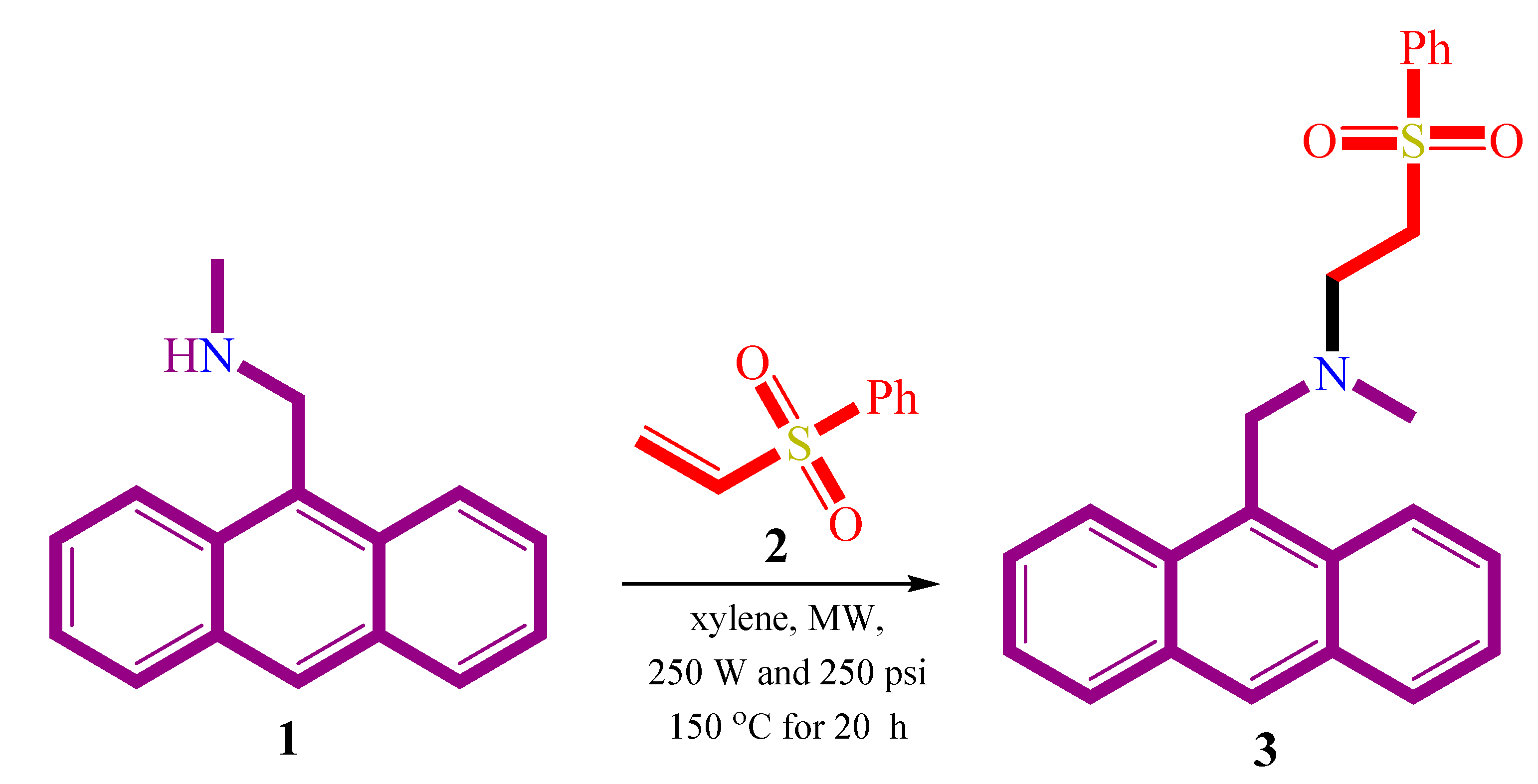
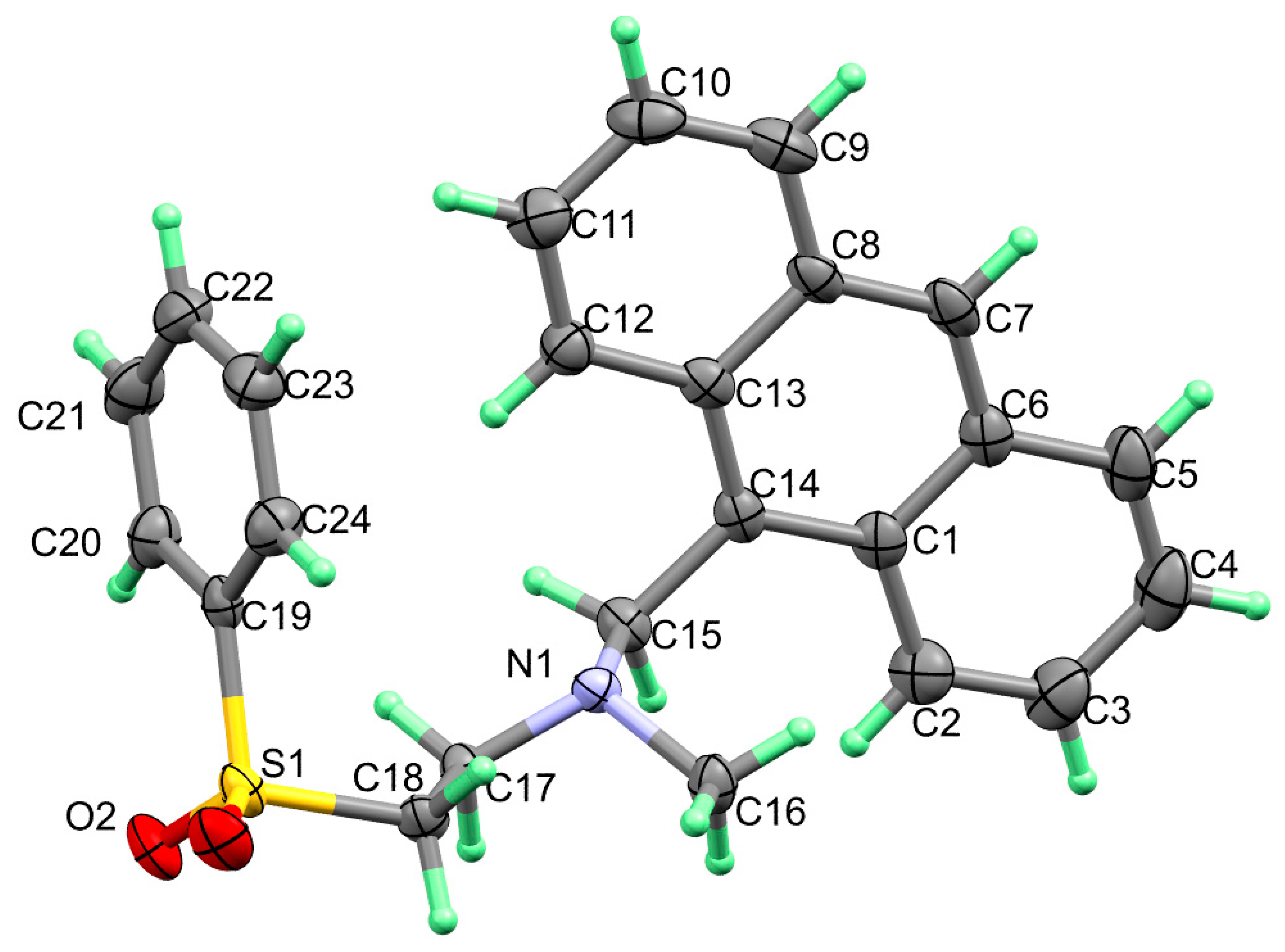
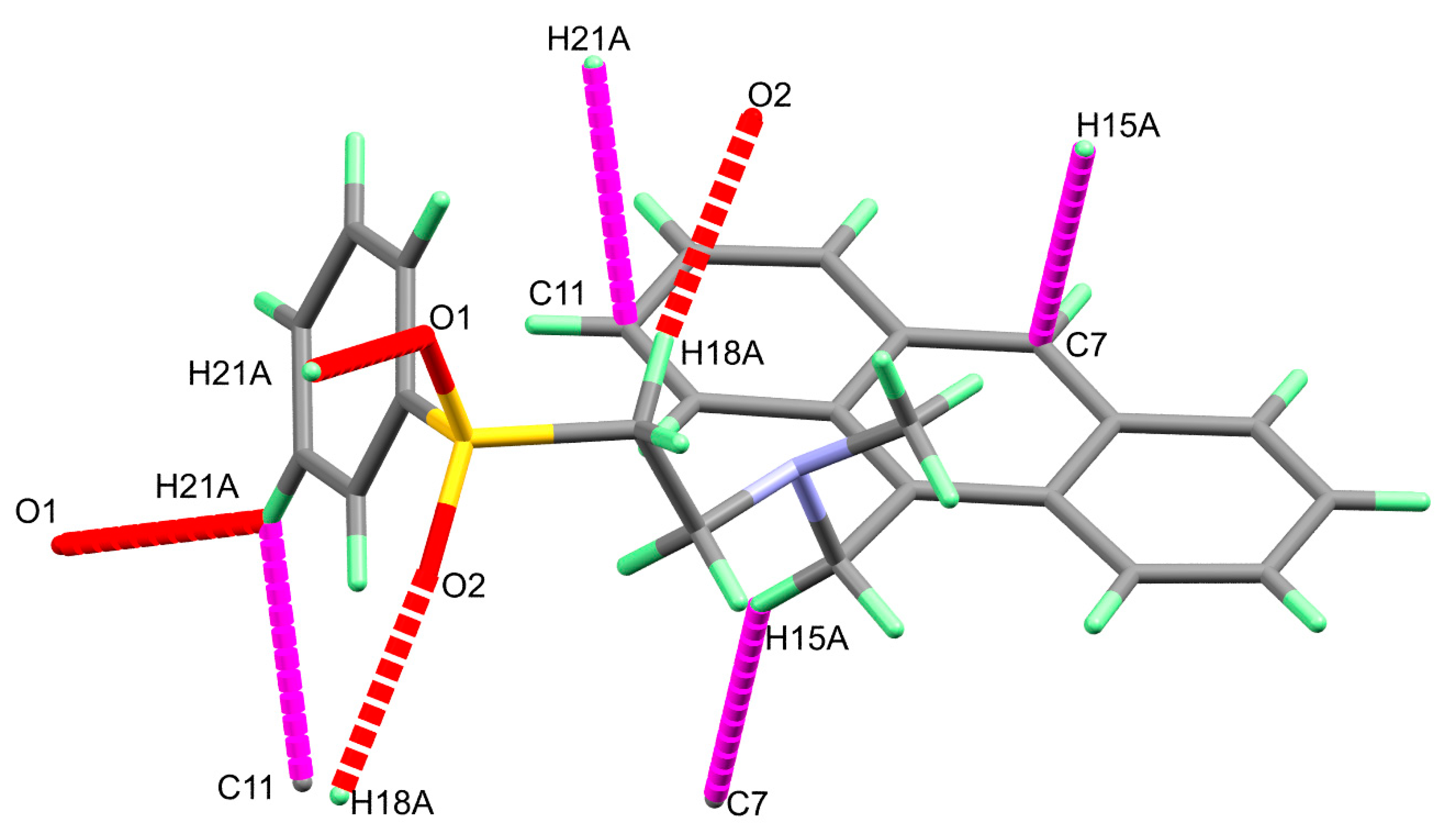
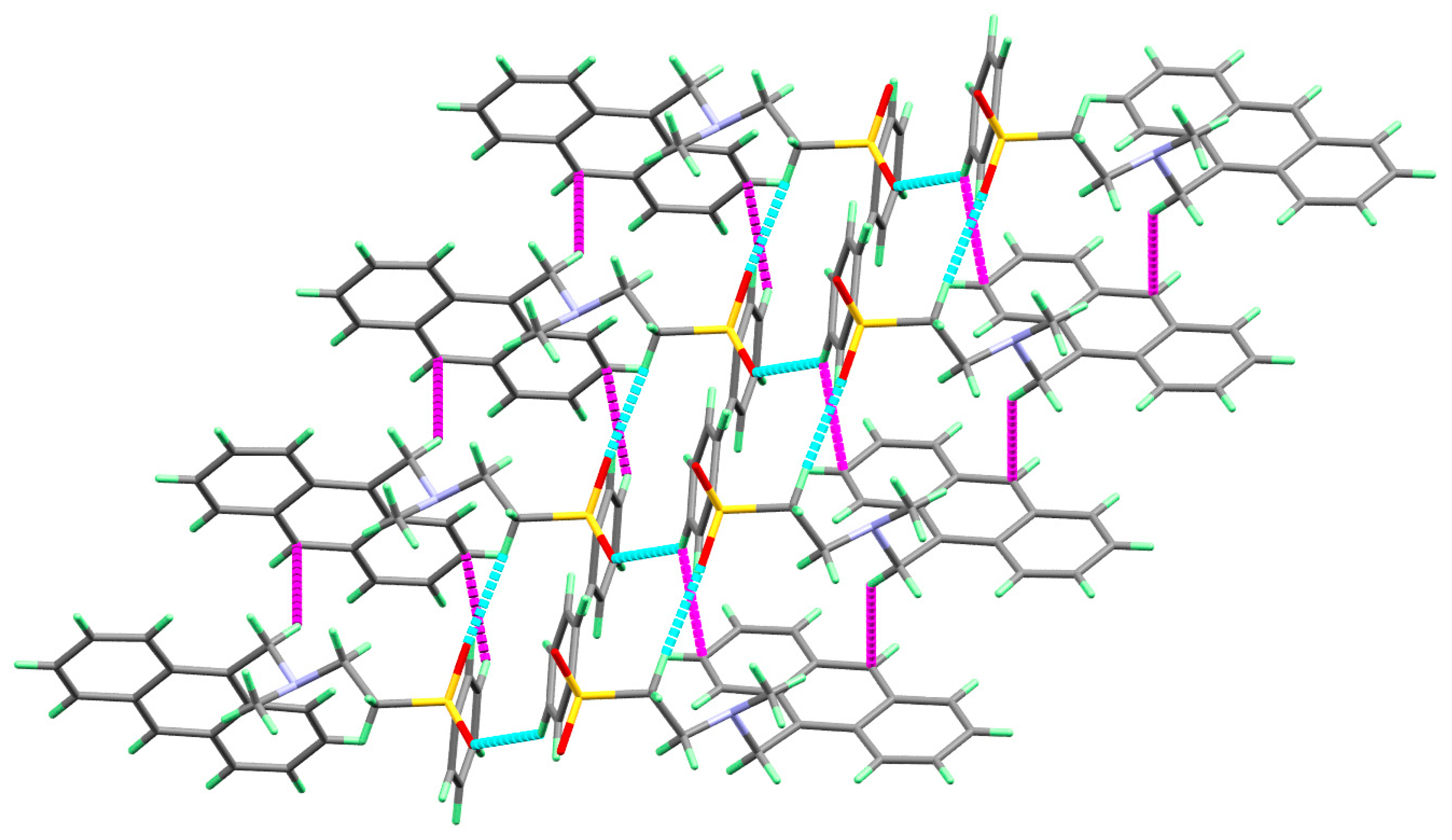

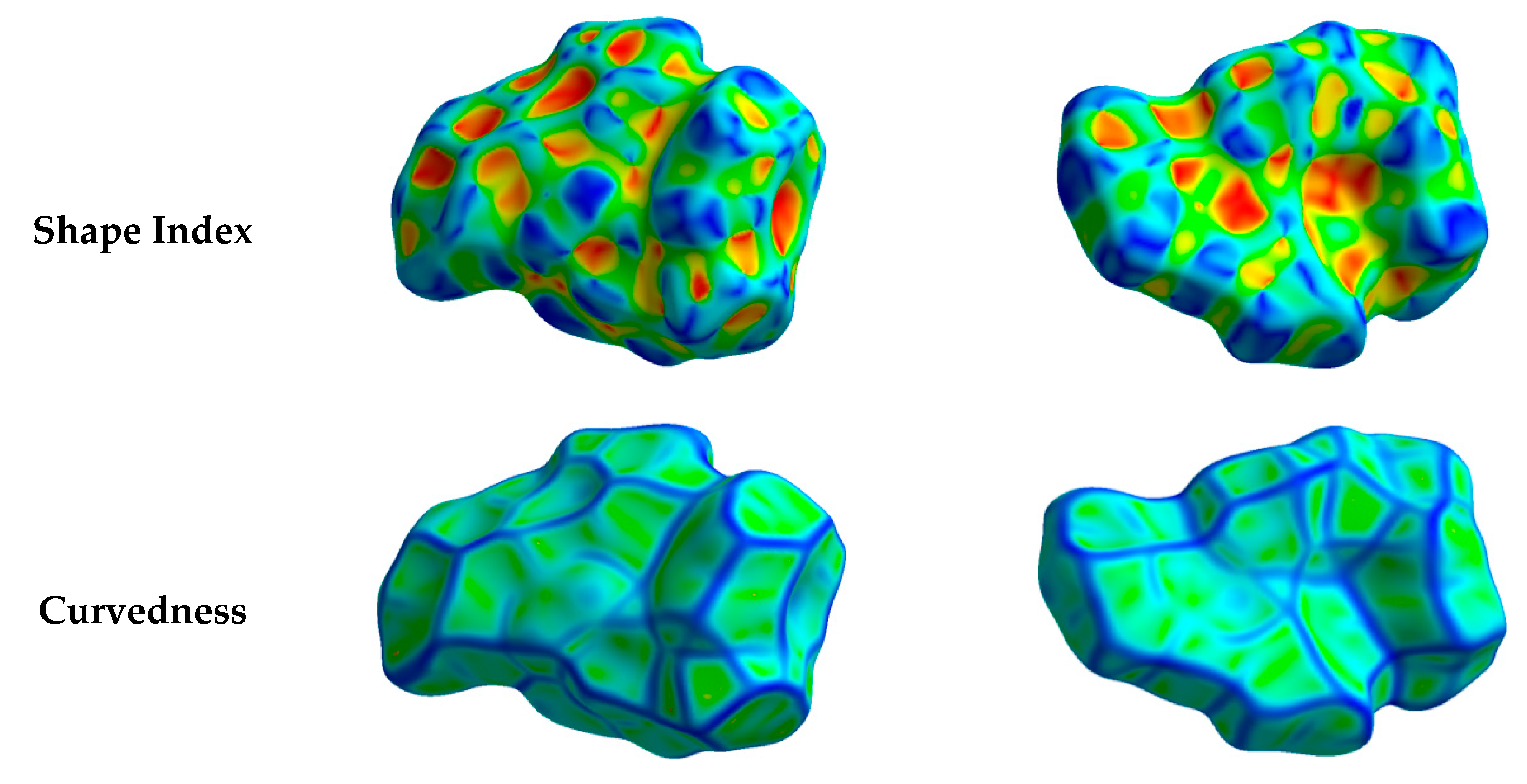

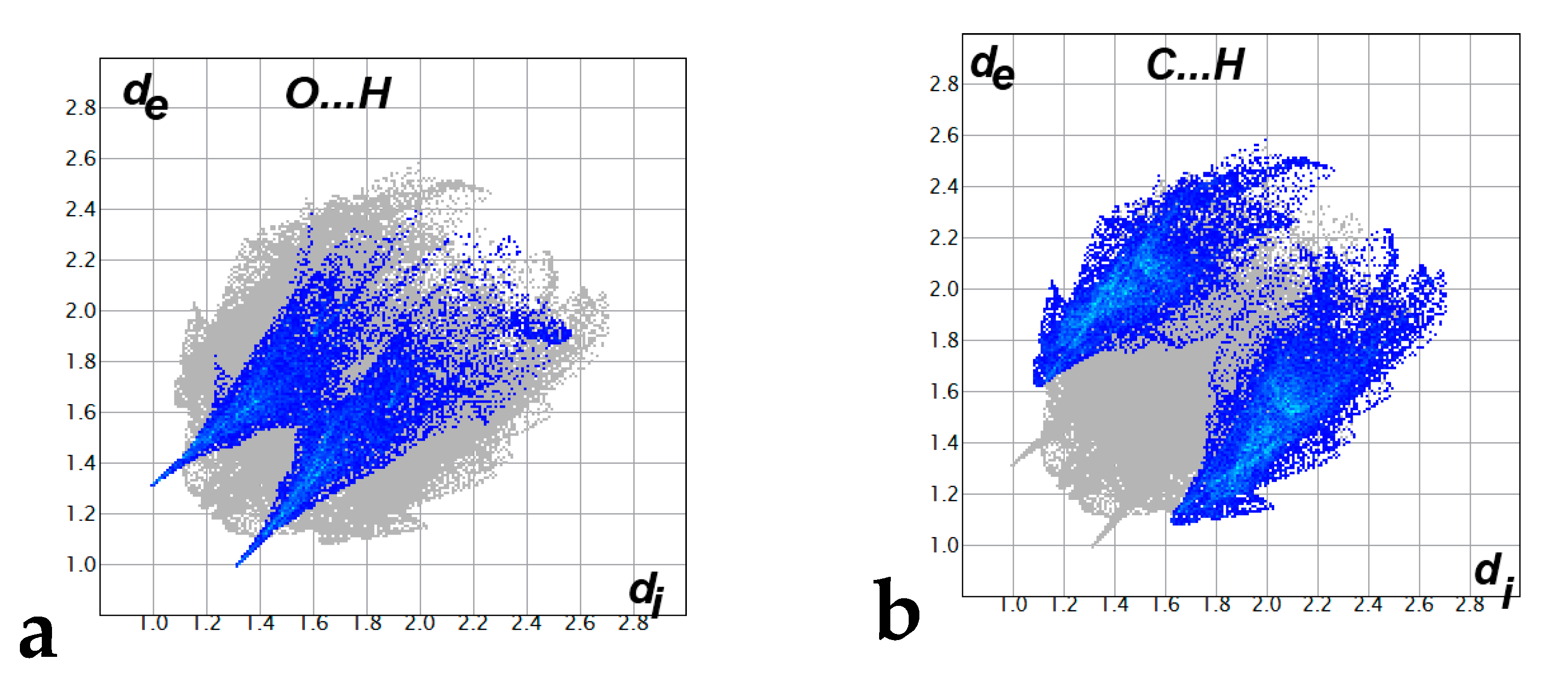



| Crystal Data | |
|---|---|
| Chemical formula | C24H23NO2S |
| MWt | 389.49 |
| Crystal system, space group | Monoclinic, P21 |
| Temperature (K) | 293 |
| a, b, c (Å) | 5.6755 (6), 14.7098 (16), 12.0407 (13) |
| β (°) | 94.139 (4) |
| V (Å3) | 1002.60 (19) |
| Z | 2 |
| Radiation type | Mo Kα |
| µ (mm −1) | 0.18 |
| Crystal size (mm) | 0.44 × 0.21 × 0.15 |
| Data Collection | |
| Diffractometer | Bruker APEX-II D8 venture diffractometer |
| Absorption correction | Multi-scan SADABS Bruker 2014 |
| Tmin, Tmax | 0.867, 0.901 |
| Number of measured, independent and observed [I > 2σ(I)] reflections | 15116, 4588, 2912 |
| Rint | 0.100 |
| Refinement | |
| R[F2 > 2σ(F2)], wR(F2), S | 0.062, 0.152, 0.94 |
| Number of reflections | 4588 |
| Number of parameters | 253 |
| Number of restraints | 1 |
| H-atom treatment | H-atom parameters constrained |
| Δρmax, Δρmin (e Å−3) | 0.21, −0.33 |
| S1—O1 | 1.441 (4) | N1—C15 | 1.478 (6) |
| S1—O2 | 1.432 (4) | N1—C16 | 1.459 (6) |
| S1—C18 | 1.765 (5) | N1—C17 | 1.450 (6) |
| S1—C19 | 1.762 (6) | ||
| O1—S1—O2 | 118.5 (2) | C15—N1—C17 | 110.2 (3) |
| O1—S1—C18 | 107.5 (2) | C16—N1—C17 | 110.5 (3) |
| O1—S1—C19 | 108.2 (2) | N1—C15—C14 | 111.1 (4) |
| O2—S1—C18 | 109.4 (2) | N1—C17—C18 | 111.1 (4) |
| O2—S1—C19 | 107.7 (2) | S1—C18—C17 | 113.4 (3) |
| C18—S1—C19 | 104.8 (2) | S1—C19—C20 | 121.1 (4) |
| C15—N1—C16 | 110.7 (4) | S1—C19—C24 | 118.3 (4) |
| D—H···A | D—H | H···A | D···A | D—H···A |
|---|---|---|---|---|
| C18—H18A···O2i | 0.97 | 2.41 | 3.347 (6) | 161.0 |
| C21-H21A…O1ii | 0.931 | 2.639 | 3.379(8) | 136.9 |
| C15-H15A…C7i | 0.971 | 2.867 | 3.621(7) | 135.2 |
| C21-H21A…C11i | 0.931 | 2.84 | 3.639(9) | 144.7 |
| (i) x − 1, y, z; (ii) 2−x,−1/2+y, −z | ||||
| Atom | Charge | Atom | Charge | Atom | Charge | Atom | Charge |
|---|---|---|---|---|---|---|---|
| C1 | −0.2892 | C27 | −0.0540 | H14 | 0.2860 | H40 | 0.2323 |
| C2 | −0.7026 | C28 | −0.0398 | H15 | 0.2711 | H41 | 0.2353 |
| S3 | 2.2117 | C29 | −0.0128 | H16 | 0.2480 | H42 | 0.2376 |
| O4 | −0.9534 | C30 | −0.2064 | H17 | 0.2460 | H43 | 0.2412 |
| O5 | −0.9554 | C31 | −0.2370 | H18 | 0.2481 | H44 | 0.2401 |
| C6 | −0.3292 | C32 | −0.2321 | H19 | 0.2662 | H45 | 0.2477 |
| C7 | −0.2206 | C33 | −0.2143 | C20 | −0.2314 | H46 | 0.2115 |
| C8 | −0.2321 | C34 | −0.2781 | C21 | −0.2401 | H47 | 0.2477 |
| C9 | −0.2175 | N35 | −0.5047 | C22 | −0.2019 | H48 | 0.2572 |
| C10 | −0.2321 | C36 | −0.4830 | C23 | −0.0545 | H49 | 0.2284 |
| C11 | −0.2196 | H37 | 0.2395 | C24 | −0.0444 | H50 | 0.1959 |
| H12 | 0.2681 | H38 | 0.2415 | C25 | −0.2198 | H51 | 0.2329 |
| H13 | 0.2077 | H39 | 0.2381 | C26 | −0.1735 | – | – |
© 2020 by the authors. Licensee MDPI, Basel, Switzerland. This article is an open access article distributed under the terms and conditions of the Creative Commons Attribution (CC BY) license (http://creativecommons.org/licenses/by/4.0/).
Share and Cite
Al-Qubati, M.; Ghabbour, H.A.; Soliman, S.M.; Al-Majid, A.M.; Barakat, A.; Sultan, M.A. Synthesis of N-(Anthracen-9-ylmethyl)-N-methyl-2-(phenylsulfonyl)ethanamine via Microwave Green Synthesis Method: X-ray Characterization, DFT and Hirshfeld Analysis. Crystals 2020, 10, 643. https://doi.org/10.3390/cryst10080643
Al-Qubati M, Ghabbour HA, Soliman SM, Al-Majid AM, Barakat A, Sultan MA. Synthesis of N-(Anthracen-9-ylmethyl)-N-methyl-2-(phenylsulfonyl)ethanamine via Microwave Green Synthesis Method: X-ray Characterization, DFT and Hirshfeld Analysis. Crystals. 2020; 10(8):643. https://doi.org/10.3390/cryst10080643
Chicago/Turabian StyleAl-Qubati, Mohyeddine, Hazem A. Ghabbour, Saied M. Soliman, Abdullah Mohammed Al-Majid, Assem Barakat, and Mujeeb A. Sultan. 2020. "Synthesis of N-(Anthracen-9-ylmethyl)-N-methyl-2-(phenylsulfonyl)ethanamine via Microwave Green Synthesis Method: X-ray Characterization, DFT and Hirshfeld Analysis" Crystals 10, no. 8: 643. https://doi.org/10.3390/cryst10080643
APA StyleAl-Qubati, M., Ghabbour, H. A., Soliman, S. M., Al-Majid, A. M., Barakat, A., & Sultan, M. A. (2020). Synthesis of N-(Anthracen-9-ylmethyl)-N-methyl-2-(phenylsulfonyl)ethanamine via Microwave Green Synthesis Method: X-ray Characterization, DFT and Hirshfeld Analysis. Crystals, 10(8), 643. https://doi.org/10.3390/cryst10080643








